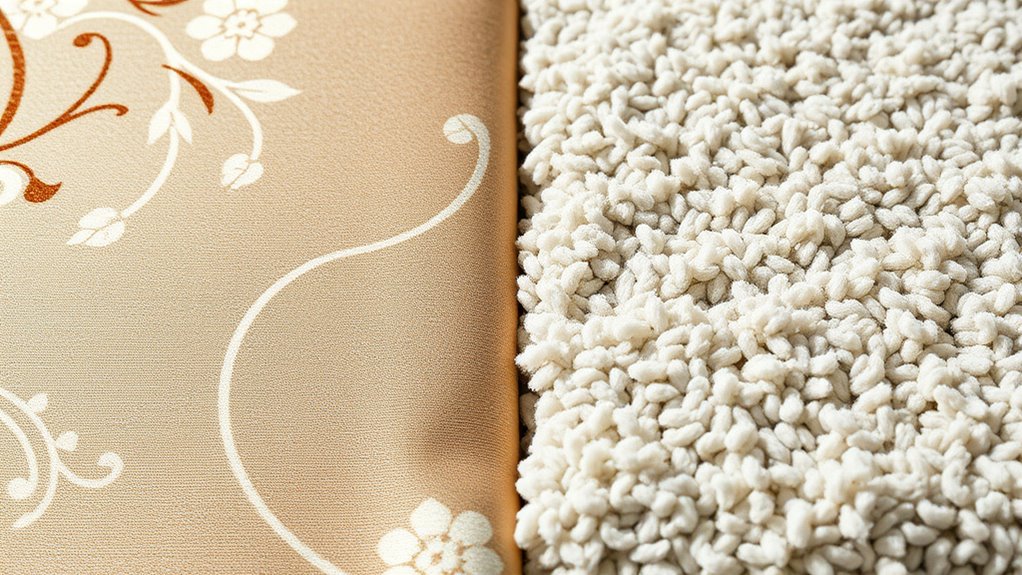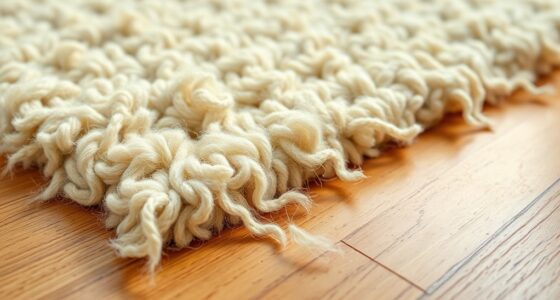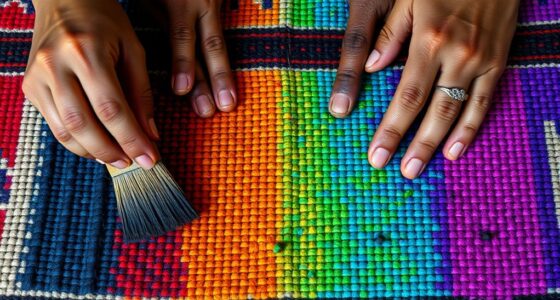Silk rugs offer a luxurious sheen and elegant appearance but are more delicate and need careful handling, especially in high-traffic areas. Wool rugs are durable, resistant to wear, and easier to maintain, making them great for everyday use. Silk’s shine adds sophistication, while wool’s natural texture creates warmth and coziness. To understand how each suits your style and needs better, you’ll find more details if you explore further.
Key Takeaways
- Wool rugs are highly durable and better suited for high-traffic areas, while silk rugs are delicate and require careful handling.
- Silk rugs have a lustrous sheen that enhances color vibrancy, whereas wool rugs feature a matte finish emphasizing texture.
- Wool is easier to maintain with routine vacuuming and deep cleaning, unlike silk, which needs gentle, dry cleaning to prevent fiber damage.
- Silk’s luxurious appearance signifies elegance but makes it more susceptible to stains and abrasion; wool is more stain-resistant and resilient.
- Wool rugs are eco-friendly, biodegradable, and sustainable, while silk’s environmental impact depends on responsible sourcing practices.
Comparing Material Composition and Texture
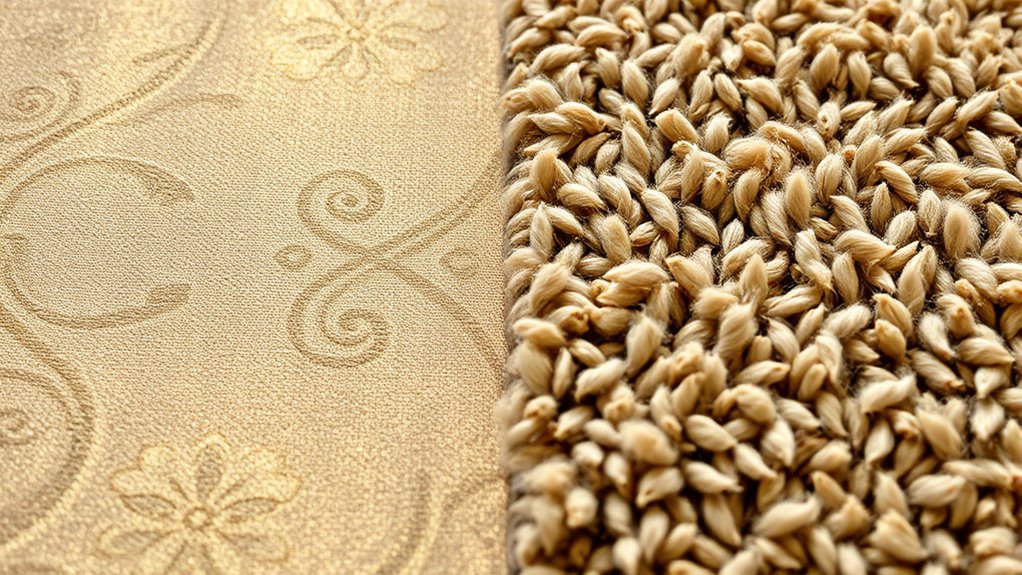
Silk and wool rugs differ markedly in both their material composition and texture. Silk rugs are made from finely spun silk fibers, resulting in a higher fiber density that creates a smooth, lustrous surface. This dense fiber arrangement gives silk rugs a soft, sleek feel and a shimmering appearance. In contrast, wool rugs use wool fibers that are thicker and more textured. Their surface texture tends to be coarser and more plush, offering a warm, cushioned underfoot experience. Wool’s fiber density varies but generally provides a more substantial, resilient surface. These differences in material composition influence not just how the rugs look but also how they feel underfoot. Recognizing these distinctions helps you choose the right rug based on your preference for texture and the feel of the material. Additionally, the integration of AI in material analysis is increasingly being used to assess the durability and quality of rug fibers, aiding consumers in making informed decisions.
Evaluating Longevity and Wear Resistance
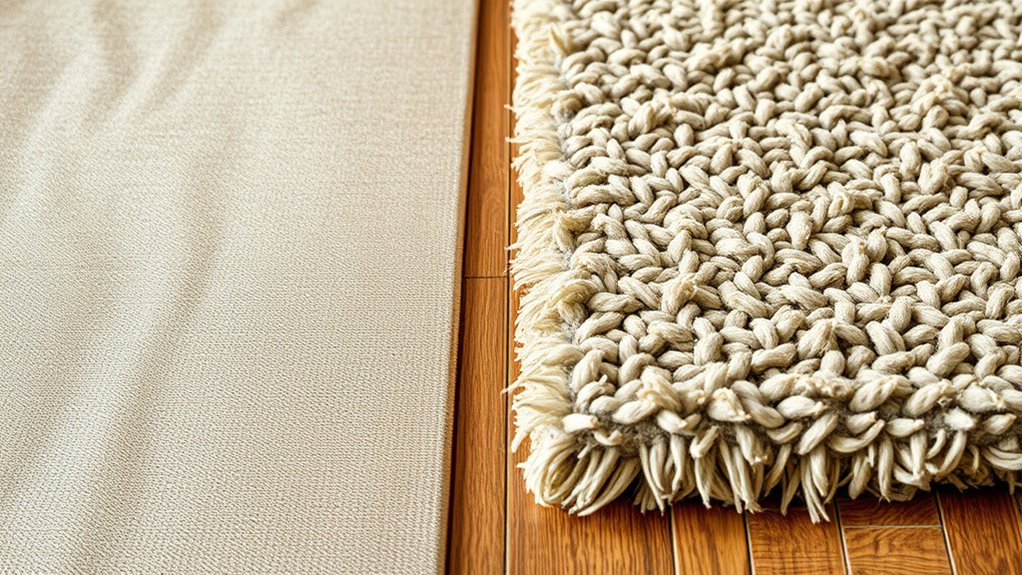
Wool rugs tend to stand up well to daily wear, making them a durable choice for high-traffic areas. Silk rugs, on the other hand, are more delicate and can be easily damaged if not handled carefully. Keep in mind that how you maintain your rug considerably affects its lifespan and resistance to wear. Additionally, avoiding color fading such as peeling or discoloration can help preserve the rug’s appearance over time. Regular cleaning and proper placement can also help in maintaining the rug’s integrity and prolonging its lifespan. Incorporating emotional intelligence into your care routine, such as understanding the specific needs of silk versus wool, can further assist in proper maintenance.
Wool’s Resilience to Wear
Because of its natural resilience, wool is renowned for its ability to withstand daily wear and tear, making it an excellent choice for high-traffic areas. Its fiber flexibility allows it to bend and bounce back without breaking, which helps prevent fraying and matting over time. Wool also offers exceptional dye stability, meaning its vibrant colors stay intact even after frequent cleaning and exposure to sunlight. This durability ensures your rug retains its appearance longer, resisting common damage like crushing or pilling. Wool’s inherent resilience minimizes the risk of permanent damage from foot traffic, making it a reliable option for busy spaces. Additionally, wool’s natural insulating properties also contribute to its popularity by maintaining comfort and temperature regulation in various environments. Its vetted reputation highlights its long-standing use in durable, high-quality rugs, further supporting its reputation for longevity. The fiber flexibility of wool not only aids in durability but also enhances its ability to recover from compression, which is essential for maintaining a fresh look over time. Wool’s moisture-wicking capabilities also help it resist mold and mildew, adding to its longevity. Overall, its combination of fiber flexibility and dye stability supports long-lasting performance, proving wool’s impressive wear resistance.
Silk’s Susceptibility to Damage
While silk rugs are prized for their luxurious sheen and delicate beauty, they are especially more vulnerable to damage from regular foot traffic and everyday wear. Their fragility concerns stem from the delicate fibers that make up the rug, which can easily snag, fray, or break under pressure. Unlike wool, silk lacks the same resilience to abrasion and stretching, making it more prone to visible wear over time. Heavy foot traffic can cause thinning areas and loss of luster, diminishing the rug’s appearance. Additionally, spills or rough handling can cause stains or fiber damage that’s difficult to repair. If you want a silk rug, be prepared for careful placement and gentle use to preserve its beauty and extend its lifespan. Maintaining proper vibrational energy around your rug can also help in preserving its delicate fibers and appearance over time. Proper cleaning methods are essential to avoid accidental damage and maintain its luxurious sheen.
Maintenance Impact on Durability
The way you care for a rug considerably influences how well it withstands daily wear and extends its lifespan. Proper maintenance enhances stain resistance, making spills easier to clean and preventing permanent damage. Regular vacuuming removes dirt and allergens that can cause fiber breakdown over time. If you neglect cleaning, allergen accumulation can worsen, affecting indoor air quality and compromising durability. Using gentle cleaning methods and prompt stain removal helps preserve the rug’s fibers, maintaining its strength and appearance. Wool rugs tend to be more resilient with routine care, while silk rugs require delicate handling to prevent damage. Additionally, choosing the right cleaning techniques and products tailored to the rug material can significantly impact its longevity and wear resistance. Incorporating vertical storage solutions can also help in protecting rugs from unnecessary exposure and damage. Ensuring proper humidity levels in your living space can further prevent fiber deterioration and mold growth, contributing to the rug’s overall durability. Maintaining optimal air circulation can also reduce moisture buildup that might otherwise harm delicate fibers. Overall, consistent maintenance directly impacts a rug’s longevity, wear resistance, and ability to withstand the rigors of everyday use.
Analyzing Natural Sheen and Aesthetic Appeal

When comparing silk and wool rugs, examining their natural sheen and overall aesthetic appeal reveals distinct qualities that influence their visual impact. Silk rugs boast a luminous sheen that enhances color vibrancy, making hues appear richer and more vivid. This natural gloss adds a sense of luxury and elegance, often elevating the room’s style. Wool rugs, by contrast, offer a softer, more matte finish, providing a cozy, understated charm. The subtlety of wool’s sheen emphasizes texture over brightness. Culturally, silk often symbolizes wealth and refinement, while wool reflects tradition and durability. Your choice depends on whether you prioritize eye-catching vibrancy and luxury or a warm, timeless aesthetic rooted in cultural symbolism. Both materials serve different visual purposes, shaping the overall ambiance of your space. Additionally, understanding the design style of your bedroom can help determine which material best complements your decor theme.
Maintenance Requirements and Ease of Cleaning
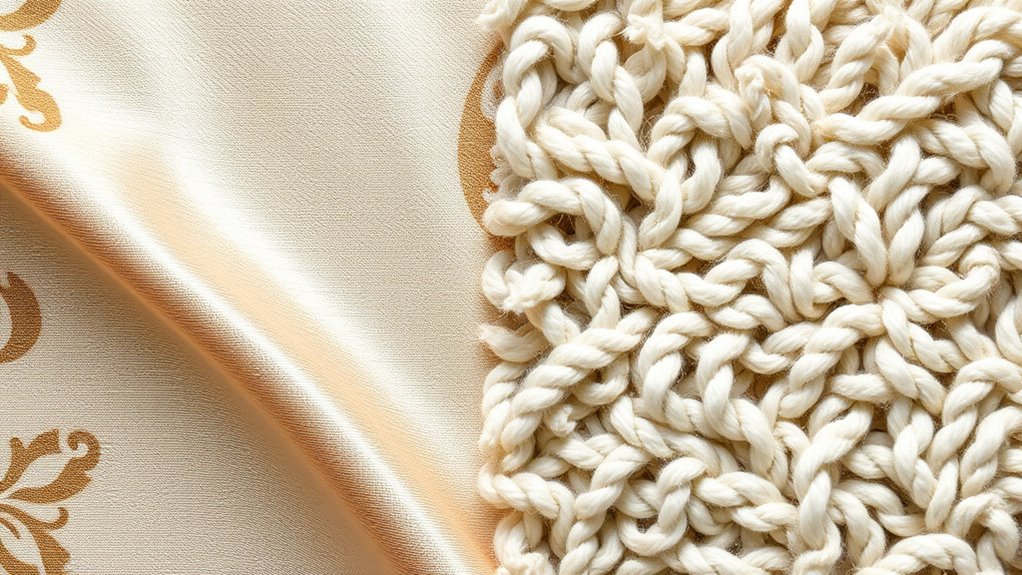
Silk and wool rugs differ markedly in how much maintenance they require and how easy they are to clean. Silk rugs are delicate, needing gentle cleaning methods like dry brushing or spot cleaning, while wool rugs are more robust and can handle vacuuming and periodic deep cleaning. Wool’s natural stain resistance makes spills easier to manage, but silk is more susceptible to stains and damage. Here’s a quick comparison:
| Feature | Silk Rugs | Wool Rugs | Common Cleaning Methods |
|---|---|---|---|
| Stain Resistance | Low | High | Spot cleaning, professional cleaning |
| Durability | Less durable | More durable | Vacuuming, gentle brushing |
| Maintenance Frequency | Less frequent | More frequent | Regular vacuuming |
| Cleaning Complexity | More delicate, careful handling | Easier to clean | Deep cleaning as needed |
| Recommended Method | Dry cleaning or spot cleaning | Vacuuming and occasional wash | Vacuum and professional cleaning |
Additionally, wool rugs are often easier to maintain due to their natural resilience and stain resistance, making them a practical choice for high-traffic areas. Proper care techniques, including regular inspection and prompt attention to spills, can extend the lifespan of both silk and wool rugs and keep them looking their best over time. Developing a maintenance routine tailored to each rug type can further help preserve their appearance and durability.
Environmental Impact and Sustainability

Both silk and wool rugs have notable environmental impacts, but their sustainability profiles differ substantially. You can consider these factors:
- Silk sourcing often involves eco-friendly methods, but some practices may harm silkworm populations. Sustainable silk farming aims to reduce this impact through responsible harvesting. Additionally, the use of biodegradable materials in silk production can influence its environmental footprint.
- Wool is biodegradable and renewable, especially when sourced ethically, reducing landfill waste.
- Eco-friendly sourcing methods for wool include pasture grazing, minimizing chemical use.
- Silk production can involve chemicals, but organic options prioritize biodegradable materials and sustainable farming.
- Additionally, sustainable farming practices for both fibers can significantly influence their overall environmental footprint.
Cost Considerations and Investment Value

While silk rugs typically come with a higher upfront cost, they are often viewed as a worthwhile investment due to their luxurious appearance and durability. Silk offers excellent cost efficiency over time because it maintains its beauty and softness longer, reducing the need for frequent replacements. Wool rugs generally cost less initially but may require more maintenance and eventual replacement, impacting their overall investment potential. When considering long-term value, silk rugs tend to retain their elegance and quality, making them a smart choice for those seeking durability and aesthetic appeal. If you’re prioritizing investment potential, silk’s timeless luxury and resilience justify the higher initial expense. Ultimately, your decision hinges on balancing immediate costs with long-term benefits and the rug’s enduring appeal.
Frequently Asked Questions
How Do Silk and Wool Rugs Perform in High-Traffic Areas?
In high-traffic areas, you’ll notice silk rugs struggle with traffic wear, as their delicate fibers can show signs of damage quickly. Wool rugs, however, are more durable and handle the durability impact better, making them suitable for busy spaces. You’ll find wool rugs maintain their appearance longer, resisting crushing and tearing, whereas silk rugs require more careful maintenance to keep them looking their best in demanding environments.
Are Silk or Wool Rugs More Resistant to Staining and Spills?
When it comes to stain resistance and spill cleanup, wool rugs generally perform better than silk. Wool fibers naturally repel liquids, making spills easier to clean and less likely to stain. Silk rugs, on the other hand, are more delicate and absorbent, so spills can seep in quickly and stain more easily. If you want a rug that stays pristine with minimal effort, wool is your best choice for stain resistance.
Which Material Is Better for Allergy Sufferers?
You might think silk or wool rugs are equally good for allergy sufferers, but the truth is, wool often triggers more allergies due to its natural lanolin content that traps dust and allergens. Silk rugs are generally hypoallergenic options, making them better for allergy triggers. If you want a rug that minimizes allergy issues, choosing silk could provide a cleaner, healthier environment for you.
Can Silk and Wool Rugs Be Dyed or Customized Easily?
When considering dyeing flexibility and customization options, silk and wool rugs offer different possibilities. You can dye both types, but silk tends to absorb dyes more vividly, allowing for brighter, more intricate designs. Wool rugs are easier to dye uniformly and can handle various customization options like patterns or color blending. Overall, both materials can be customized, but silk provides more vibrant results, while wool offers easier, more consistent dyeing.
How Do Silk and Wool Rugs Compare in Insulating Properties?
You might wonder how silk and wool rugs compare in insulation effectiveness and thermal retention. Wool rugs excel at trapping air, making them great insulators and helping retain heat in colder months. Silk rugs, while beautiful, provide less thermal retention due to their smoother fibers. If insulation is your priority, wool offers better thermal performance, keeping your space warmer and more energy-efficient.
Conclusion
Choosing between silk and wool rugs depends on your priorities. Silk offers a stunning sheen and luxurious feel, but it’s more delicate, with only about 20% of silk rugs lasting over 20 years. Wool, on the other hand, is more durable and easier to maintain, making it a practical choice. Ultimately, your decision balances beauty, longevity, and eco-friendliness—so consider what matters most to you for a lasting, stylish investment.
